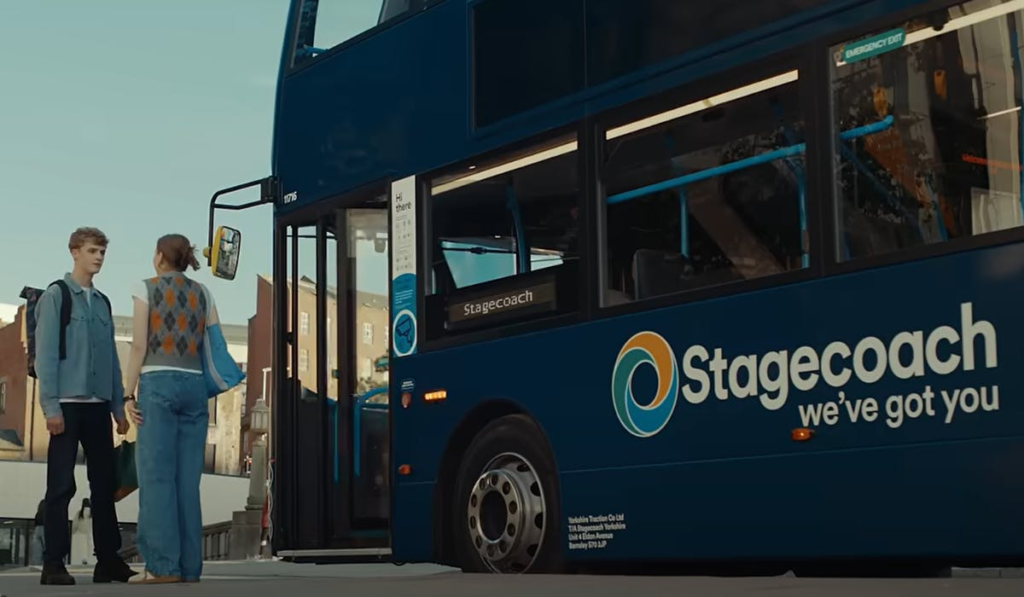 Stagecoach is aiming to shift long-standing perceptions that bus travel is cheap, unreliable and slow with its new brand promise and nationwide campaign.
Stagecoach is aiming to shift long-standing perceptions that bus travel is cheap, unreliable and slow with its new brand promise and nationwide campaign.
The UK bus operator is aiming to tackle the stigma around bus travel and build greater “emotional resonance” with its brand as it looks to reposition the bus as a smart, sustainable and modern choice.
“[Bus travel] has been seen as the compromised choice, or potentially not always the smart choice,” Stagecoach’s head of brand marketing Jaeger Rowland tells Marketing Week.
 Stagecoach is aiming to shift long-standing perceptions that bus travel is cheap, unreliable and slow with its new brand promise and nationwide campaign.
Stagecoach is aiming to shift long-standing perceptions that bus travel is cheap, unreliable and slow with its new brand promise and nationwide campaign.
The UK bus operator is aiming to tackle the stigma around bus travel and build greater “emotional resonance” with its brand as it looks to reposition the bus as a smart, sustainable and modern choice.
“[Bus travel] has been seen as the compromised choice, or potentially not always the smart choice,” Stagecoach’s head of brand marketing Jaeger Rowland tells Marketing Week.
According to a 2023 survey by Transport Focus, a majority (70%) of non-bus users prefer to travel by car, while 27% said the bus was less convenient and another 27% said journeys took too long.
“We’re not telling people to go and ditch the car, because that is a big ask, but we’re certainly asking that people consider the bus for certain journeys,” she notes. “There is a positive impact on the environment and the community when that happens.”
We hope to overcome those more negative perceptions and persuade people to get on the bus.
Jaeger Rowland, Stagecoach
Serving around 3 million people across the UK each day, Stagecoach has launched a new brand promise, ‘We’ve got you’, alongside a nationwide campaign aimed at connecting with audiences on a more “emotional level” by highlighting the role the bus plays in supporting communities.
The idea is to reposition bus travel from being seen as “cheap” to being viewed as “good value”.
“By elevating the brand – making it look sleek and chic, making it comfortable, making it really safe – we hope to overcome those more negative perceptions and persuade people to get on the bus,” Rowland says.
This marks Stagecoach’s first significant investment in brand marketing, which Rowland described as a “big leap of faith”.
A turning point
The new campaign and brand promise went live at the end of July, during what the company describes as a “transitional” period as it moves towards a more customer-focused strategy.
Using insights from Kantar, Stagecoach discovered it had high brand awareness but low consideration.
“People already saw us as friendly and likeable, and surprisingly reliable,” she says. “Negative feedback sometimes has a louder voice, but seeing that we already were known to be reliable, friendly and likeable gave us this credible platform to build from.”How Virgin Atlantic and Great Western Railway defied travel category norms
Still, Rowland says the brand lacked personality and edge. She saw a “big opportunity” to move away from functional messaging and begin telling a more emotionally resonant story.
The previous brand promise ‘Proud to Serve’ no longer felt “fit for purpose” as it was developed just before Covid and now lacked resonance.
“It didn’t feel like it would support us moving forward, and we also found it has a huge amount of misattribution to it,” she says. “As we’ve matured, it just doesn’t feel right for us anymore.”
The new creative was tested with System1 and, according to Rowland, scored ‘exceptional’ and ‘strong’ in the spike and star ratings, demonstrating it was the “right direction” to help deliver long-term growth and drive consideration at the top of the funnel.
“A lot of the time people don’t think of the bus at all. They will look to other modes of transport, but just being considered is ultimately what we want to do. Hopefully people get on the bus and give it a try,” she notes.
Stagecoach is also backing up its campaign with improvements to the customer experience. This includes launching a new fleet of buses with upgraded seating, removing internal advertising in favour of “nicer” messaging, enhancing audio-visual elements and updating the app.
“We deliberately designed the bus not to feel like what you’d expect a bus to look and feel like,” she says. “We invested in customer research and making sure that it was safe in terms of the direction we were taking it.”Don’t make brand models harder than they already are
The campaign, created with creative agency Supersonic, takes a video-first media strategy, running across connected TV (CTV), broadcast video-on-demand (BVOD), subscription video-on-demand (SVOD), YouTube, online video and Stagecoach’s owned digital channels
It’s being rolled out nationally, but with targeted layers to reach specific audiences with relevant messaging at key travel moments. For instance, the brand is targeting NHS workers along hospital routes.
This is Stagecoach’s biggest brand campaign to date, with increased investment in content that highlights both customers and the people behind the scenes. It also marks one of the first times the brand has advertised on TV.
“This campaign is very video-first and we’re investing a lot more in terms of ensuring that we have more content and information that feels native to the different platforms,” she says.
The brand will track impact through increases in Net Promoter Score, consideration uplift and increased digital engagement. Alongside the external campaign, Stagecoach has worked closely with service representatives to ensure the brand is well represented in customer interactions.
“We have around 25,000 people, so it was really important that we bought everyone on the journey internally first, before we started talking about it externally,” she adds. “It’s been a significantly different approach for us.”


